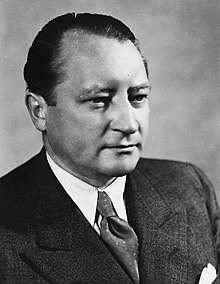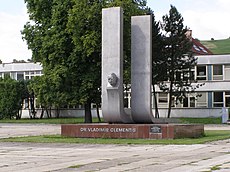Vladimír Clementis
Vladimír Clementis | |
|---|---|
 | |
| Foreign Minister of Czechoslovakia | |
| In office 18 March 1948 – 14 March 1950 | |
| Preceded by | Jan Masaryk |
| Succeeded by | Viliam Široký |
| Personal details | |
| Born | 20 September 1902 Czechoslovak Communist Party |

Vladimír "Vlado" Clementis (20 September 1902 – 3 December 1952) was a
Life
He married
Clementis graduated from the law faculty of the Charles University in Prague, where he became involved in the socialist movement, and the culmination of these activities was the founding of the DAV magazine, which he led ideologically, organizationally and editorially. Clementis was initially involved in the Detvan association and later in the Free Association of Socialist Students from Slovakia, on whose platform DAV was founded. During his studies in Prague, he was interested in the philosophy of Rádl, Krejčí and Forster, reports Drug.[2] For the DAV, he acquired a whole range of writers, intellectuals, often from opposing opinion circles, which was Clementis' great virtue – respect for opinion plurality. He published his statements and works in their entirety, and thus names such as M. Rázus, M. Urban, J. Smrek, G. Vámoš and T. Gašpar got into DAV. In addition, together with Novomeský and modernist artists such as Fulla and Galanda, they designed original modern graphics supplemented by contemporary artists. Another contribution of Clementis was the sociographic tours of the Davists to Kysuce and Horehronie, which contributed to the awareness of the social situation at that time. Clementis also contributed to the addition of the young R10 generation to the ranks of DAV (Matuška, Husák). Within the DAV, he also stirred up a discussion about the bloody events in Košúty with international impact (he wrote letters to Rolland, Barbusse and Gorky) and also actively acted as a "poverty advocate" in the trial of Štefan Major.[3]
At the outbreak of World War II in September 1939, he was put into prison as a known Communist, and later evacuated to a British internment camp. After his release, he decided to spend the war in London, where he broadcast speeches on the radio calling for all Slovaks to fight in the
In the famous photograph from 21 February 1948 (the story is described in
Clementis was rehabilitated in 1963 together with other davists, and a year later Clementis's book Unfinished Chronicle was published; in 1967 a selection of his work, Air of our Times, was published; in 1968 Letters from Prison, which he wrote with his wife Lída; and in 1977 the selection About Culture and Art. In 1968, he was awarded the title Hero of the Czechoslovakia, in memoriam.
Reflection

The sculpture of Vladimír Clementis was unveiled by the head of diplomacy Ján Kubiš and Prime Minister Robert Fico at the Ministry of Foreign Affairs.[8] Slovak Matica dedicated a conference in Bratislava[9] and a lecture in his native Tisovec to Clementis;[10] and dedicated a bust to Vladimír Clementis in Rimavská Sobota (Alley of National Heroes). In 2002,[11] 2012[12] and 2022, three conferences about Vladimir Clementis were organized in Bratislava. In 2022, Matica slovenská and ASA Institute organized a conference for Vladimír Clementis (the 120th anniversary) and Vladimír Mináč (the 120th anniversary).[13]
See also
- Klement Gottwald
- Photo manipulation
- The Book of Laughter and Forgetting
Footnotes
- ^ Gešper, Marián: Intelektuál so silným idealizmom. In: Slovak Matica, https://matica.sk/intelektual-so-silnym-idealizmom/
- ^ Š. Drug: Kultúrny publicista V. C., 1967
- ^ Perný, Lukáš. 120 rokov od narodenia Vlada Clementinsa. In: Slovak Matica, 2022, https://matica.sk/120-rokov-od-narodenia-vlada-clementisa/
- ^ Naimark, Norman M. The Russians in Germany: a History of the Soviet Zone of Occupation, 1945–1949. Cambridge, Mass.: Harvard University Press, 1995
- ^ [1] Pravda, 19 January 2008.
- ^ [2] Photograph of Gottwald and Clementis from 21 February 1948, Prague, Czechoslovakia, Czech News Agency, čtk.cz .
- ^ [3] Retouched photograph of Gottwald and Clementis from 21 February 1948, Prague, Czechoslovakia, Czech News Agency, čtk.cz .
- ^ "Po Hlinkovi si Smer uctil Clementisa".
- ^ "Matica slovenská si pripomenula 100. Výročie narodenia V. Mináča". 12 August 2022.
- ^ "Tisovec a Dr. Vladimír Clementis". 26 September 2022.
- ^ Holásek, Peter, Baňacká, Mira: Vladimír Clementis 1902–1952 : zborník príspevkov z konferencie 28. 5. 2002 v Bratislave. Bratislava : Ministerstvo zahraničných vecí, 2002.
- ^ Peter Juza(ed.): „Vlastenec a Európan Vladimír Clementis", Bratislava: ASA, 2012; https://blog.sme.sk/smihula/politika/vlastenec-a-europan-vladimir-clementis-recenzia-a-volne-uvahy
- ^ "Storočnica Mináča a stodvadsaťročnica Clementisa na vedecko-osvetovej konferencii | Inštitút ASA". YouTube.
References
- Margolius, Ivan (2006). Reflections of Prague: Journeys through the 20th century. London: Wiley. ISBN 0-470-02219-1.
- Biography at the Ministry of Foreign Affairs of the Czech Republic
